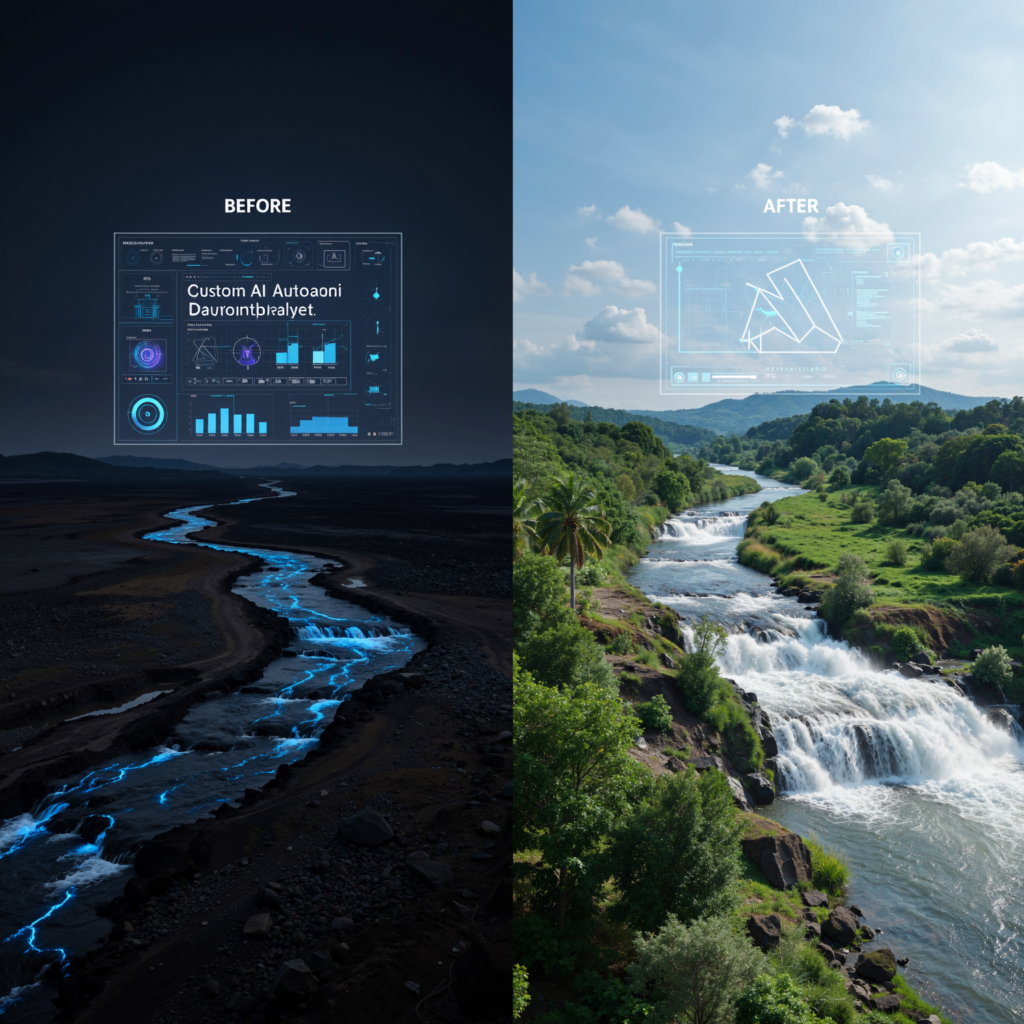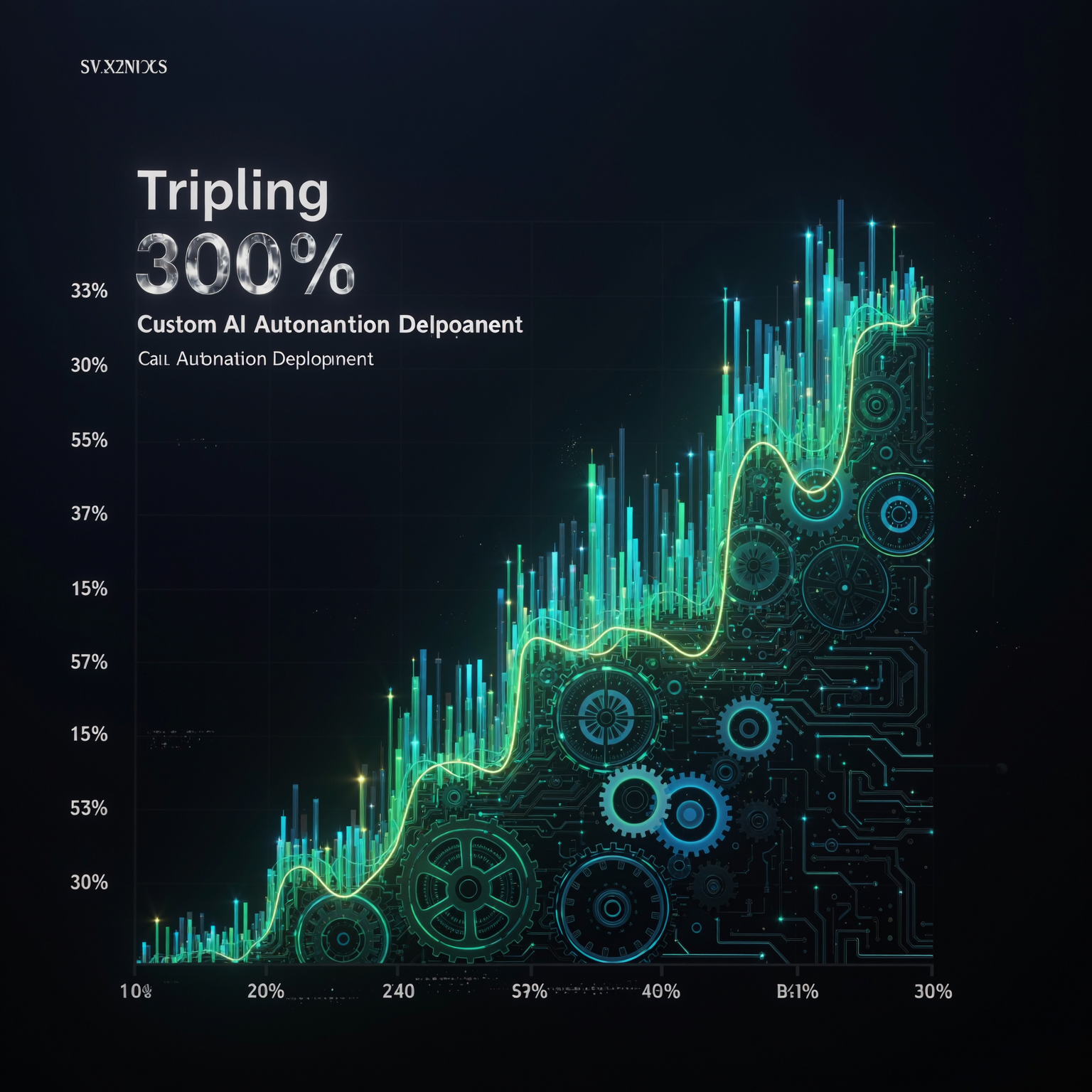In our two decades of experience, we’ve learned that marketing theory is one thing, but results are everything. It’s easy to talk about the potential of artificial intelligence and automation. It’s another thing entirely to see it transform a business from the inside out. This is the story of that transformation. It’s a real-world look at how we took a promising, yet struggling, mid-sized B2B technology company and completely overhauled their lead generation engine, not with generic software, but with a custom-built AI automation deployment. The result? We didn’t just increase their leads; we tripled their pipeline of sales-qualified opportunities in six months. This case study isn’t about abstract concepts; it’s a blueprint of the exact challenges, strategies, and AI-powered solutions that turned a stagnant marketing function into a predictable, high-performance growth machine.

The client: a familiar story of frustration
To protect their privacy, we’ll call our client “InnovateTech.” They are a brilliant software company based in Europe, offering a sophisticated SaaS solution for the logistics industry. Like many B2B companies, they had a fantastic product, a team of passionate experts, and a respectable roster of early clients. But they had hit a wall. Their growth had plateaued, and their marketing efforts felt chaotic and inefficient, creating a palpable sense of frustration for their entire leadership team.
Diagnosing the core challenges
When InnovateTech first came to us, they presented a situation we see all too often. Their marketing was a collection of disconnected activities, not a cohesive system. During our initial deep-dive audit, we identified four critical points of failure that were strangling their growth:
- The Leaky Bucket: They were generating a decent volume of “top-of-funnel” leads through webinars and whitepaper downloads. However, the follow-up process was entirely manual. A lead might download a resource, and it could take days for a busy sales representative to send a generic follow-up email. By then, the prospect’s interest had cooled, and the opportunity was lost.
- Overworked Sales, Underqualified Leads: The sales team was spending an estimated 60% of their time chasing leads that were never going to convert. They were treating a student who downloaded a paper for research with the same urgency as a logistics manager from a Fortune 500 company who requested a demo. This not only wasted valuable sales time but also created significant friction and low morale between the marketing and sales departments.
- Generic, One-Size-Fits-All Messaging: Every lead, regardless of their industry, company size, or the specific content they engaged with, was thrown into the same generic email newsletter. There was no personalization, no attempt to nurture leads with content relevant to their specific pain points. As a result, email engagement was abysmal, and leads quickly went cold.
- No Data, Just Guesses: They had a wealth of data sitting in their CRM, website analytics, and email platform, but it was all siloed. They had no way to connect the dots. They couldn’t tell which marketing channels were producing the best leads, what content was most effective at moving prospects through the funnel, or what the true ROI of their marketing spend was. Every decision was based on gut feelings and anecdotal evidence.
This combination of manual processes, poor lead qualification, and a lack of data-driven insight had created a perfect storm of inefficiency. They were working incredibly hard just to stand still.
The solution: designing the custom AI automation blueprint
Our proposal wasn’t about simply buying a new piece of marketing automation software. Off-the-shelf software is just a tool; without a strategic blueprint, it’s like handing a novice a set of professional power tools and expecting them to build a house. We proposed a ground-up redesign of their entire lead management process, powered by a custom-deployed AI engine designed to solve their specific challenges. Our work focused on four key pillars.
Pillar 1: building the intelligent lead capture and scoring engine
The first step was to fix the “leaky bucket” and ensure the sales team only focused on the hottest leads.
- Unified Data Integration: We began by connecting their website, CRM (Salesforce), and email platform into a single, unified data ecosystem. This allowed our AI models to have a 360-degree view of every interaction a prospect had with the InnovateTech brand.
- AI-Powered Predictive Lead Scoring: We then built a custom lead scoring model. This AI didn’t just look at basic demographic data like job title or company size. It analyzed dozens of behavioural signals in real-time. For example:
- A lead who visited the pricing page twice and viewed a specific case study was assigned a higher score than someone who only downloaded a top-of-funnel whitepaper.
- Engagement with email content, webinar attendance, and even the speed at which they moved through the website were all factored in.
- The AI learned over time, constantly refining the model by analysing which leads ultimately converted into customers.
- Automated Sales Alerts: When a lead’s score crossed a pre-defined “sales-qualified” threshold, the system automatically triggered an alert to the appropriate sales representative. This alert didn’t just contain the contact’s name; it provided a full summary of their activity, showing the salesperson exactly what the prospect was interested in. This allowed them to initiate a highly relevant, timely conversation instead of a cold call.
Pillar 2: deploying the dynamic and personalized nurturing pathways
Next, we addressed the generic messaging. We built an automated system to ensure every lead received content that felt like it was created just for them.
- Real-Time Content Personalization: We segmented their entire lead database based on industry (e.g., retail logistics vs. pharmaceutical logistics) and their demonstrated interest.
- Dynamic Nurturing Sequences: We then created a series of “nurturing pathways.” When a new lead entered the system, the AI would automatically place them into the appropriate pathway. For instance:
- If a lead from the pharmaceutical industry downloaded a whitepaper on cold chain logistics, they would automatically receive a sequence of emails with a relevant case study, an invitation to a webinar on compliance, and an article about new regulations.
- If a different lead from the retail sector engaged with content about last-mile delivery, their nurturing path would focus on e-commerce integration, inventory management, and customer success stories from retail brands.
- Behaviour-Triggered Communication: The system was dynamic. If a lead on one pathway suddenly visited a page about a different service, the AI could automatically shift them to a more relevant nurturing sequence. This ensured the communication was always aligned with the prospect’s current interests.
Pillar 3: implementing the 24/7 AI sales assistant (chatbot)
To further qualify leads and provide instant support, we deployed an AI-powered chatbot on the InnovateTech website. This was not a simple, rules-based bot.
- Natural Language Processing (NLP): The chatbot could understand complex user queries and engage in natural-sounding conversations. It could answer frequently asked questions, direct users to relevant resources on the site, and, most importantly, qualify visitors.
- Intelligent Lead Qualification: The bot was programmed to ask key qualifying questions (e.g., “What is your biggest logistics challenge right now?” or “How many shipments do you manage per month?”). Based on the answers, it could determine if a visitor was a good fit.
- Automated Demo Booking: For highly qualified prospects, the chatbot could integrate directly with the sales team’s calendars and book a demo on the spot, completely removing the friction of back-and-forth emails. This meant InnovateTech was capturing high-intent leads 24/7, even when their sales team was asleep.
Pillar 4: establishing the AI-driven analytics and insights hub
Finally, we replaced their guesswork with a clear, data-driven view of their entire marketing and sales funnel.
- Unified Performance Dashboard: We built a single, live dashboard that visualized the entire customer journey. It showed, in real-time, the number of new leads, the number of Marketing Qualified Leads (MQLs), the number of Sales Qualified Leads (SQLs), and the final conversion rate.
- Attribution Modeling: The AI-powered system could finally connect the dots. It showed InnovateTech exactly which marketing channels (e.g., organic search, LinkedIn ads, guest articles) were generating not just the most leads, but the most valuable leads that turned into customers. This allowed them to stop wasting money on underperforming channels and double down on what was working.
The results: a complete business transformation
We implemented the core of this system over a period of 90 days. The results, tracked over the following six months, were transformative and far exceeded our initial projections.
- 312% Increase in Sales-Qualified Leads: This was the headline metric. By automating the qualification process and ensuring sales only spoke to high-intent prospects, the number of quality opportunities entering the pipeline more than tripled.
- 50% Reduction in Sales Cycle Length: Because leads were better educated and nurtured before ever speaking to a salesperson, the time it took to close a deal was cut in half.
- 40% Increase in Marketing-Sourced Revenue: The ultimate metric. The system didn’t just generate more leads; it generated more customers, directly proving the ROI of the new, intelligent marketing engine.
- A Healed Marketing & Sales Relationship: One of the most satisfying results was cultural. With a clear, data-driven definition of a “good lead” and a system that delivered them consistently, the old friction between the marketing and sales teams disappeared. They were finally aligned, working as a single, cohesive growth team.
Your blueprint for intelligent growth
The story of InnovateTech is not an outlier. It’s a powerful example of what becomes possible when you stop thinking about marketing as a series of manual tasks and start thinking of it as a single, intelligent system. By strategically deploying AI-driven automation, we were able to eliminate inefficiency, personalize the customer journey at scale, and provide the data-driven clarity needed to make smart decisions. This process liberated their team from the frustrating, repetitive work that was causing burnout and allowed them to focus on the high-level strategy and creative thinking that only humans can do. It didn’t just boost their numbers; it restored their confidence and set them on a predictable path to becoming a leader in their industry.








